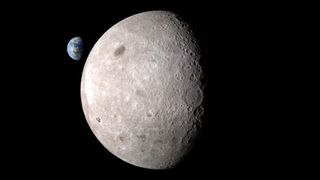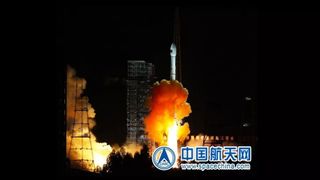Rocket will collide with the moon tomorrow. Here's what you need to know.
The 3-ton rocket will be traveling at 5,771 mph when it smashes into the moon.

A 3-ton (2.7 metric tons) discarded rocket stage will smash into the moon Friday (March 4) while traveling at 5,771 mph (9,288 km/h). Here's everything you need to know before it happens.
When and where will it collide with the moon?
The space junk is expected to punch a dent near the moon's far side equator at Hertzsprung crater at 7:25 a.m. EST (1225 GMT) Friday.
What is it?

The debris is the 3-ton discarded upper stage of a rocket sent from Earth sometime in 2014. It was first detected in March 2015 by telescopes in Arizona that form the backbone of the Catalina Sky Survey, and since then, it has been monitored by Bill Gray, a U.S. astronomer and the developer of the asteroid-tracking software Project Pluto.
Gray first thought the debris was from a SpaceX Falcon 9 rocket sent to space in February 2015 to deliver the Deep Space Climate Observatory, but more recent evidence now points to the space junk being the upper stage of a rocket from China's Chang'e 5-T1 mission, which launched in October 2014 as part of a test mission to send a sample capsule to the moon and back. However, Chinese foreign ministry officials dispute this idea, Live Science previously reported.
Related: 5 strange, cool things we've recently learned about the moon
Can you watch the rocket crash?
Because the collision will take place on the moon's far side, the impact will be impossible to view using Earthbound telescopes. We may see the crater in the next few weeks or months, however. Satellites orbiting the moon, such as NASA's Lunar Reconnaissance Orbiter and India's Chandrayaan-2 spacecraft, may not be in the right spot to capture the collision as it happens, but they will eventually be able to identify the object's impact crater once they've orbited overhead.
Will it damage the moon?
Unlike the doomsday scenario in the movie "Moonfall," the junk's impact won't cause any significant damage to the moon beyond adding another crater to its already-pockmarked surface. At the instant the rocket strikes the moon, a shock wave will travel through the impactor in mere milliseconds, shattering it into chunks of exploding metal. A second shock wave will also travel into the moon's dusty upper surface, heating up rocks and dust sufficiently to produce an enormous flash while sending a plume of material flying hundreds of miles high. Nothing will remain of the rocket other than the crater it caused, which will be an estimated 33 to 66 feet (10 to 20 meters) in diameter, The New York Times reported.
Sign up for the Live Science daily newsletter now
Get the world’s most fascinating discoveries delivered straight to your inbox.
Although this is the first unintentional lunar collision, it isn't the first time a human-made satellite has crashed into the moon. In 2009, NASA fired its Lunar Crater Observation and Sensing Satellite into the moon's south pole at 5,600 mph (9,000 km/h), unleashing a jet of material that enabled scientists to detect the key signatures of water ice. NASA also deliberately disposed of the Saturn V rockets used for the' Apollo missions by firing them into the moon.
What could scientists learn from it?
Scientists are excited to observe the new crater for two reasons.
First, because we know the speed and size of the object smashing into the moon's surface, researchers hope that the size of the dent caused by the impactor could provide a useful yardstick for judging other craters on the moon, enabling them to estimate the size and speed of past asteroids.
Second, because scientists know very little about the composition of the moon's subsurface, they hope the impact will give them a better understanding of this little-studied region.
Originally published on Live Science.

Ben Turner is a U.K. based staff writer at Live Science. He covers physics and astronomy, among other topics like tech and climate change. He graduated from University College London with a degree in particle physics before training as a journalist. When he's not writing, Ben enjoys reading literature, playing the guitar and embarrassing himself with chess.
